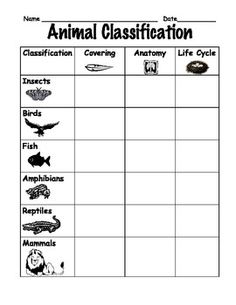Animal Classifications Worksheets Groups
Animal classifications worksheets are a valuable resource for teachers and parents seeking to engage elementary and middle school students in the fascinating world of biology. These worksheets provide a structured way to introduce and reinforce the concept of animal groups, allowing students to explore the different characteristics and classifications that define each group. With clear and concise explanations, students can learn about the main categories of animals and the unique features that distinguish them from one another.
Table of Images 👆
More Other Worksheets
Kindergarten Worksheet My RoomSpanish Verb Worksheets
Cooking Vocabulary Worksheet
DNA Code Worksheet
Meiosis Worksheet Answer Key
Art Handouts and Worksheets
7 Elements of Art Worksheets
All Amendment Worksheet
Symmetry Art Worksheets
Daily Meal Planning Worksheet
What are the characteristics of mammals?
Mammals are characterized by having hair or fur on their bodies, mammary glands that produce milk to nourish their young, a four-chambered heart, a diaphragm for breathing, and a constant body temperature maintained through internal processes. Additionally, mammals give birth to live young, although some species lay eggs. Mammals also have unique skeletal features such as ear bones and specialized teeth for different diets, contributing to their diverse adaptations and ecological success.
How do birds differ from other animals?
Birds differ from other animals in several ways, including having feathers, beaks, laying eggs, and possessing unique skeletal structures that enable flight. Additionally, birds have a high metabolic rate and lightweight bodies, allowing for efficient and sustained flight. Their respiratory system also differs, with birds having air sacs that facilitate a continuous flow of air through their lungs, increasing oxygen exchange during flight.
What are the main characteristics of reptiles?
Reptiles are cold-blooded vertebrates with scales or scutes, and they typically lay shelled eggs on land. They have a muscular body with limbs that are usually well-developed for walking, running, climbing, or swimming. Reptiles breathe through lungs and have a tough, waterproof skin that helps prevent water loss. Most reptiles have a simple three-chambered heart and are carnivorous, feeding on insects, small mammals, birds, or other reptiles. Additionally, many reptiles undergo shedding of their skin as they grow.
Describe the distinguishing features of amphibians.
Amphibians are ectothermic vertebrates with moist, permeable skin that allows them to breathe through their skin, in addition to lungs. They typically have a larval stage in water, followed by a terrestrial adult stage, and most go through metamorphosis during their life cycle. They have a three-chambered heart and lay eggs in water or moist environments. Amphibians are distinct for their ability to live both on land and in water, making them unique among vertebrates.
What makes fish distinct from other animal groups?
Fish are distinct from other animal groups due to their aquatic nature, gills for respiration, and streamlined body shapes for swimming in water. They also have scales covering their bodies, fins for movement and stability, and a swim bladder for buoyancy control. Additionally, fish reproduce by laying eggs and have a unique sensory system that includes a lateral line for detecting movement and vibrations in the water.
What are the key characteristics of insects?
Insects are characterized by having six legs, three main body parts (head, thorax, abdomen), a pair of antennae, compound eyes, and usually two pairs of wings. They also typically undergo metamorphosis, with four stages in their life cycle: egg, larva, pupa, and adult. Insects have an exoskeleton made of chitin that provides support and protection. They play crucial roles in ecosystems as pollinators, decomposers, and as a food source for other animals.
How do arachnids differ from insects?
Arachnids differ from insects in several ways. Firstly, arachnids have eight legs while insects have six legs. Additionally, arachnids have two main body segments (cephalothorax and abdomen) while insects have three (head, thorax, and abdomen). Another key difference is that arachnids do not have wings or antennae, which are present in insects. Finally, arachnids usually have simple eyes or no eyes at all, while insects typically have compound eyes.
Describe the main attributes of crustaceans.
Crustaceans are characterized by having a hard exoskeleton made of chitin, jointed appendages, and a segmented body. They typically have two pairs of antennae, compound eyes, and gills for respiration. Crustaceans exhibit a wide range of sizes, from tiny copepods to large lobsters, and are found in various aquatic environments such as oceans, rivers, and lakes. They play important roles in ecosystems as both predators and scavengers, contributing to the overall biodiversity of marine and freshwater habitats.
What are the distinguishing features of mollusks?
Mollusks are defined by several distinguishing features, including a soft body typically enclosed in a shell made of calcium carbonate, a muscular foot for movement, a visceral mass containing their organs, and a mantle that covers their body and produces the shell. They also possess a radula for feeding, a coelom, and most have a well-developed nervous system with sensory organs. Mollusks are an incredibly diverse group of invertebrates that include animals like snails, clams, squids, and octopuses, exhibiting a wide range of adaptations and behaviors across their various species.
How do echinoderms differ from other animal classifications?
Echinoderms differ from other animal classifications in several key ways. They are unique due to their radially symmetric bodies, with usually five arms radiating from a central disc. Echinoderms also possess a water vascular system that helps them with movement and feeding through tube feet. Another distinguishing feature is their endoskeleton made up of ossicles, which are small calcium carbonate plates under their skin. Additionally, echinoderms have a regenerative ability that allows them to regrow lost body parts. These characteristics separate echinoderms from other animal groups, making them a distinctive and fascinating phylum within the animal kingdom.
Have something to share?
Who is Worksheeto?
At Worksheeto, we are committed to delivering an extensive and varied portfolio of superior quality worksheets, designed to address the educational demands of students, educators, and parents.


































Comments